Forgetting and Inventing: Of Ancient Cities and Space Colonies
"I Forgot More Than You'll Ever Know"
- Bob Dylan
Inventing doesn't mean to always come up with new ideas to solve problems, but mostly to combine and use old technology in new ways.
There are always new problems, but when they are broken down (function analysis) the separate parts can be solved using existing technology.
When talking about existing technology, then it also involves technology that might already have been forgotten and needs to be uncovered. Parts of very complex modern problems can be solved by very old technology.
An Example of Extremes
Elon Musk spoke in his Reddit AMA about the possibility of tunneling robots that would prepare underground shelters before colonists arrive on Mars. There was also a competition from Nasa to find a great design for a mining robot.
Just thinking about the environment in space makes it visible how important mining robots will be:
- Almost all solid ground outside earth will be sand or solid, since no vegetation exists.
- Missing shielding from radiation has to be made from living under cover by digging tunnels or building shelters from local resources.
- Manpower is scarce, highly valuable and thus worth being done by robots.
- Using explosives might not be a smart idea.
- A mining robot must have very low wear, so that it can operate a long time without maintenance.
- Low gravity makes it difficult to push a conventional drill.
Finding something that is robust and easy to use today is pretty hard. Most tools are robust, but only as far as it is inconvenient to get a replacement drill. Solutions for use above that are hard to find.
Looking in the Past: Megalithic Architecture
In many parts of the earth, stone structures where found that display unrivaled stone carving proficiency.
Sacsayhuama, Peru
Near the city of Cusco is a megalithic structure, called Sacsayhuama. The local ancient culture managed to carve huge boulders to fit perfectly together to form a giant wall. The stones were fitted together without mortar and can still be found like they were originally placed.

Sacsayhuama near Cusco, Peru. Source
Notice that Peru lies in an earthquake prone region and that there are only few trees at this altitude. Still people were able to carve and move this stones.
Tiahuanaco, Bolivia
In Bolivia several works of the Tiwanaku culture can be found. They were able to carve fine and precise stones, that still weighted several ton.
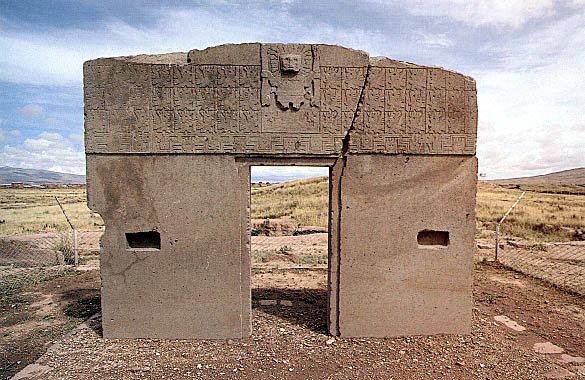
Gate of the Sun at Tiahuanaco, believed to be over 14,000 years old. Source
This and similar parts were found covered by errosion. This slab of stone, called Gate of the Sun, weighs 10 tons and was carved from one piece, before it eventually broke and then left abandoned. The hard stone shows smooth surfaces and right angles, that are very hard to make by hand, especially with prehistoric tools.
Baalbek, Lebanon
During their time in the middle east, the Romans build a lot of colossal buildings. While the Romans themselves show a high mastery in building with stones, they build their temples on the structures of the Canaanites, which were 2000 years older than the Romans and even they could have build on older foundations, as the culture of the oldest part of the main structure is unknown.
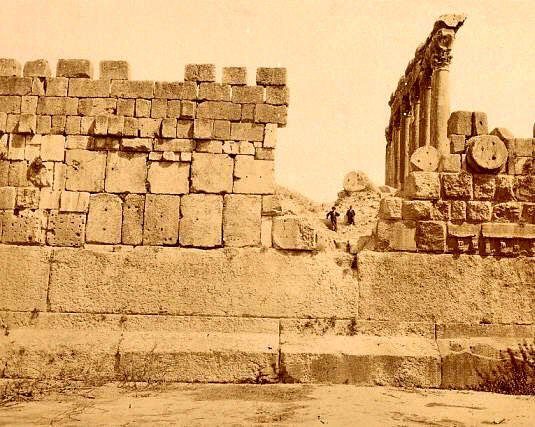
The giant walls in Baalbek. Notice the two people looking down from it. Source
The monumental size of the boulders lets you wonder how this is even possible. The stones for the foundation weight up to 1500 ton, the biggest worked stones in the world. The stones also show markings unrelated to the Roman culture.
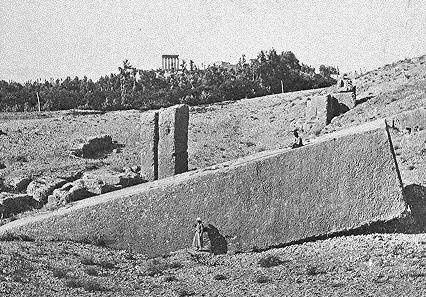
A giant stone still left in the quarry. It is the largest tooled stone, estimated to weigh 2000 ton. Source
Buildings like that leave questions after questions, as long as nobody is able to repeat this work.
Longyou caves, China
When pumping out a small lake to get to the fish, a Chinese villager discovered that the lake had a lot more water in it than expected. A few hours pumping stretched into 17 days and what was discovered was really unexpected.
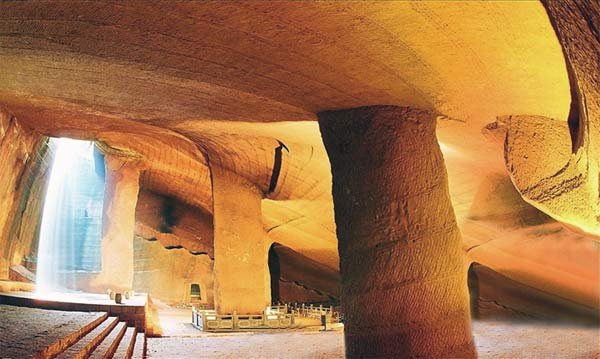
Huge halls were carved into the stone. Source
The lake turned out to be the entrance to an underground city. Huge halls and pathways were carved into the stone. In the following weeks, the pumping was repeated on surrounding ponds and 24 caves where found in total.
While it was indeed a curious find, there was a hidden the riddle: the Chinese where famous for their bureaucracy in ancient times and everything was documented into detail. Still, nothing was found about an underground operation, which must have moved a million cubic meters of stone.
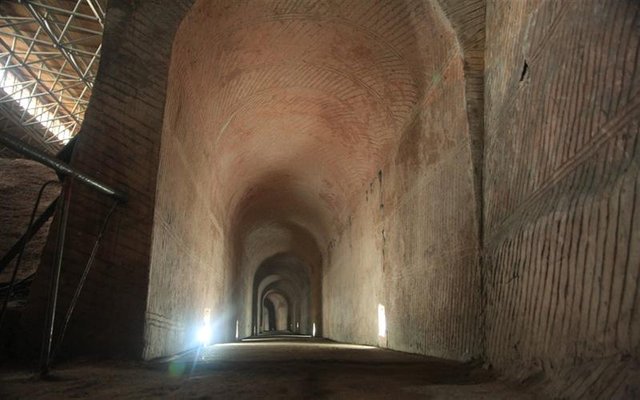
The roofs where up to 30m high. Source
What was also interesting, that no dead fish where found, as if they moved away during the pumping. No damage was found as well. The whole structure was still in contact, after over 2000 years (it is estimated to have been made in a period before the creation of the Qin Dynasty in 212 BCE)

Notice the rough carving marks. Source
What was remarkable as well was that no tools where found. The origins of the tunneling technique is thus still in the dark.
Why is this so interesting?
Somehow there were people in ancient times, that were able to carve out a whole city, which should have cost millions of dollars with modern technology. But while someone would have probably been able to come up with enough motivation to get people to work, the question is how they actually made it happen.
If there is a way to find out how this carving was done, without machines or electricity, then it could revolutionize mining if it was combined with today's technology.
How was it done?
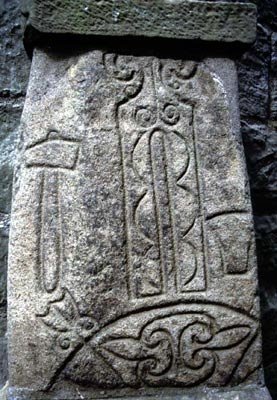
A tuning fork symbol next to a hammer might be an indication that it has been used as a tool. Source
Many ideas where thrown around to explain this almost unbelievable feat. From Aliens, to a forgotten, human, super intelligent ancestor to technology that can melt stone.
One theory was made due to the noticeable acoustics of the ancient structures and found carvings (as seen above).
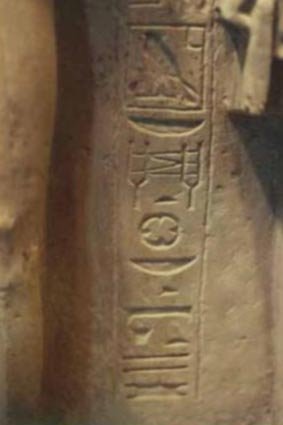
Another pair of tuning fork symbols. Here it is imagined that they are used to translate frequencies. Source
A good formulated article lays out the theory, that special designed tuning forks where used. It is imagined that chanting in a specific tone would be used to incite vibration in theses tools. The vibration is translated into a movement which can be used to hammer stone.
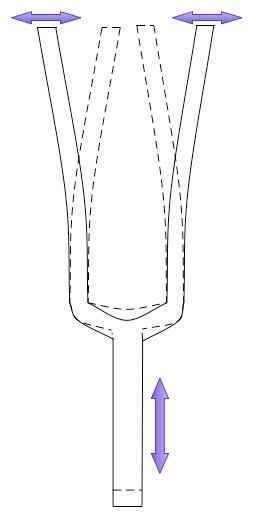
The sound induces a radial motion of the arms, which translate to a longitudinal motion of the tip of the tuning fork. Source
This drill would not work by cutting or scraping the stone, but by hammering it. Thus it is not important how hard the rock is: Since the rock is not elastic, it forms plastic all the time and thus loses its integrity and breaks into smaller pieces. An ultrasonic drill would use this principle by deforming the stone just a little bit, but very often, which turns the stone into dust.
Applying the Lesson
What can be seen is that a remarkable technique was used to carve stones without using explosives, electricity, pneumatics and hydraulics. Even if it is not done with such a "prehistoric sonic drill", the technical explanation stands its test in so far, that ultrasonic drilling is possible:

An ultrasonic drill build by NASA. Source
There are indeed already several types of ultrasonic drills in operation. They have low wear and use high vibration to crush through hard stone.
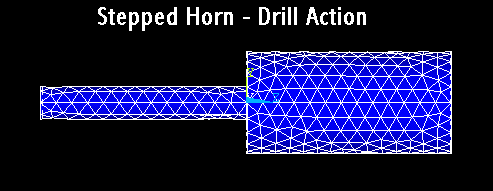
Operation principle of the USDC, driven by piezoelectric actuated percussive mechanisms. Source
It was also found out that the mechanics of fast small shocks have unique abilities:
- They can be used to drill glass.
- It is possible to drill even very hard rock, like obsidian, quartz or marble.
- The wear of the drill is very low.
- Only little pressure is needed, since the drill does the forward movement himself to hit the stone.
- It works fine in a wide variety of temperatures and even in Vacuum.
- The drill bit can cut out a contour, so it is able to have a hollow drill to extract a sample.
It is not known thought, if they used the ancient tuning fork drill as an inspiration.
Conclusion
New products for new problems can combine old solutions in new ways for exciting new technology.
Keeping an eye in the past thus definitely counts. There have been remarkable engineering achievements that have been overlooked because we had access to cheap energy.
If someone can get away with the lack of efficiency of driving 10 km to work every day. Meanwhile he is surrounded by a ton of metal, with an engine that is heating the environment more than it develops toque. In that case one can imagine the lack of efficiency in the industry. A lot is just possible by using a lot of power that is cheap and almost abundant.
Not only is the technology less efficient, but the imagination gets lazy: Problems that can't be solved by using bigger machines seem impossible.
But with a change of environment, this power is limited. The lack of efficiency can become obvious and common techniques are not sufficient anymore. Instead of raw power, technology has to become smarter. New solutions have to be found.
Maybe you have an idea?
Thank you for reading!
If you like this article, I would be very happy if you did me a favor and resteem it!
Follow me also for more on Engineering and Technology.
When you are interested in building your own product, read my 13 Steps to your Product.
If you have further questions, feel free to contact me on:
This post has been linked to from another place on Steem.
Learn more about and upvote to support linkback bot v0.5. Flag this comment if you don't want the bot to continue posting linkbacks for your posts.
Built by @ontofractal
The BBC's Connections with James Burke was all about how inventions developed over time, often by exactly the amalgamation process you describe here. http://topdocumentaryfilms.com/james-burke-connections/
That looks interesting! Thank you
I often look back at the documentary "Everything is a remix"
One of my favorites as well. I think he's done an update recently.
Can you replace the megalithic tag with science? I think more people check there and your posts are great and deserve more views!
I fully agree :)
That is a great advice!
Guess I need to step up my tag game ;)
The right tags will give your good posts more visibility :)
Really good post!
Thank you!
It was fun to write too.
Another riveting article. I wonder if that city is open to the public.
It seems so. Trip adviser even has a good review.
Definitly worth a visit!
https://www.tripadvisor.com/Attraction_Review-g677479-d1373164-Reviews-Longyou_Grottoes-Longyou_County_Zhejiang.html